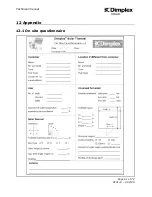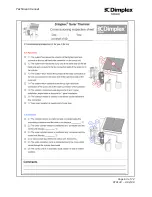
Technical manual
Page 49 of 72
ST0133 – A 02/09
SOLAR
For an initial assessment the following sizing guide (Figure 50) can be used to discuss
the feasibility of solar. It is however recommended, following the completion of the siz-
ing guide to complete the On Site Questionnaire as shown in Figure 49 and Appendix
11.1 to validate the initial sizing with a detailed solar fraction simulation.
The solar fraction achieved using the sizing guide shown in Figure 50 will vary depend-
ing on the location of the installation within the UK (see Figure 3), its orientation (see
Figure 5) and the actual hot water demand.
6 Pipe work
For installation where the Dimplex solar corrugated stainless hose SOLFH10/15 is not
suitable, it is required to specify the correct pipe work for the installation.
6.1 Type of pipe work
Only full metal pipe work must be used in solar thermal installations. Plastic or compos-
ite materials are not suitable due to the high temperatures that can occur in solar ther-
mal installations and the compatibility with the heat transfer medium.
Due to its ease of use and the readily available fittings it is recommended to use copper
as pipe material. Steel pipe work can also be used when it is ensured that it always
terminates into a brass fitting before getting in contact with copper.
The joints of the pipe work must be carried out in such a way that they are suitable for
the pressure and the temperatures present in the solar thermal system. For copper pipe
work it is recommended to work with brass compression fittings with brass olives.
6.2 Pipe work sizing
The size of the pipe work depends primarily on the flow rate circulating through the pipe
work. As discussed in Chapter 4.1.2 each collector requires a specified flow rate to en-
sure optimum operation and efficiency.
Equation 11 can be used to calculate the minimum required inner pipe diameter ID_min
in mm:
w
V
ID
&
⋅
=
6
.
4
min
[9]
Where: ID
min
[mm]
minimum required pipe diameter
4.6
[-]
unit conversion factor
V
[l/min]
flow rate through pipe
w
[m/s]
flow velocity through pipe
Due to the higher viscosity of the heat transfer medium in comparison to water the flow
velocity w should not exceed 0.5 to 0.7m/s. A number of typical pipe diameters for
various collector field sizes are given in Figure 51 with a flow velocity of 0.5 and 0.7m/s.
Summary of Contents for Solar Series
Page 1: ...Page 1 of 72 ST0133 A 02 09 SOLAR Technical Manual Complete guide to Dimplex Solar ...
Page 61: ...Technical manual Page 61 of 72 ST0133 A 02 09 SOLAR 12 Appendix 12 1 On site questionnaire ...
Page 62: ...Technical manual Page 62 of 72 ST0133 A 02 09 SOLAR 12 2 On site inspection ...
Page 63: ...Technical manual Page 63 of 72 ST0133 A 02 09 SOLAR ...
Page 64: ...Technical manual Page 64 of 72 ST0133 A 02 09 SOLAR ...
Page 68: ...Technical manual Page 68 of 72 ST0133 A 02 09 SOLAR ...
Page 69: ...Technical manual Page 69 of 72 ST0133 A 02 09 SOLAR ...
Page 70: ...Technical manual Page 70 of 72 ST0133 A 02 09 SOLAR ...
Page 71: ...Technical manual Page 71 of 72 ST0133 A 02 09 SOLAR ...
Page 72: ...Technical manual Page 72 of 72 ST0133 A 02 09 SOLAR 13 Notes and sketches ...
















































